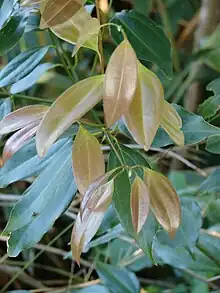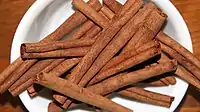Cinnamomum burmanni
Cinnamomum burmanni (or Cinnamomum burmannii), also known as Indonesian cinnamon, Padang cassia, Batavia cassia, or korintje, is one of several plants in the genus Cinnamomum whose bark is sold as the spice cinnamon. It is an evergreen tree native to southeast Asia.
| Indonesian cinnamon | |
|---|---|
 | |
| Scientific classification | |
| Kingdom: | Plantae |
| Clade: | Tracheophytes |
| Clade: | Angiosperms |
| Clade: | Magnoliids |
| Order: | Laurales |
| Family: | Lauraceae |
| Genus: | Cinnamomum |
| Species: | C. burmanni |
| Binomial name | |
| Cinnamomum burmanni (Nees & T.Nees) Blume[2] | |
| Synonyms[2] | |
|
Synonymy
| |
Description
Cinnamomum burmanni is an evergreen tree growing up to 7 m in height with aromatic bark and smooth, angular branches.[3] The leaves are glossy green, oval, and about 10 cm (3.9 in) long and 3–4 cm (1.2–1.6 in) wide.[4] Small yellow flowers bloom in early summer,[5] and produce a dark drupe.[3]
Distribution
Cinnamomum burmanni is native to Southeast Asia and Indonesia.[6] It ranges from Bangladesh to Myanmar, southern China, Hainan, Taiwan, Vietnam, Borneo, Sumatra, Java, Sulawesi, the Lesser Sunda Islands, and the Philippines.[2]
In Sumatra C. burmanni is commonly found in West Sumatra and western Jambi province, with the Kerinci region being especially known as the center of production of quality, high essential-oil crops.
On Borneo it occurs in Sabah (Keningau, Lahad Datu, Ranau, Sandakan and Sipitang districts) and Kalimantan, where it found in cultivation and in secondary forest, villages, and abandoned plantations to 1,500 metres elevation.[7]
C. burmanni is an introduced species in parts of the subtropical world, particularly in Hawaiʻi, where it is naturalized and invasive.[3][4] It was introduced to Hawaiʻi from Asia in 1934 as a crop plant.[8]
Use
Aromatic oil can be extracted from the bark, leaves, and roots of Cinnamomum burmanni. The bark is also used as a cinnamon bark. The leaves can be used as a spice for preserved food and canned meat instead of laurel leaves. The core contains fat, which can be squeezed for industrial use. The wood is used for fine furniture and other fine work materials. C. burmanni is also a Chinese herbal medicine.[9]
The most common and cheapest type of cinnamon in the US is made from powdered C. burmanni.[10] C. burmanni oil contains no eugenol,[11] but higher amounts of coumarin than C. cassia and Ceylon cinnamon with 2.1 g/kg in an authenticated sample, and a mean of 5.0 g/kg in 8 samples tested.[10] It is also sold as quills of one layer.[11]
Gallery
 Flower. The flower has six to eight petals.
Flower. The flower has six to eight petals. flower sprays
flower sprays gall
gall spice bark
spice bark Inflorescence axillary.The new stems is red, which is one of the characteristics of C. burmannii.
Inflorescence axillary.The new stems is red, which is one of the characteristics of C. burmannii. The ternate vein is protruding on the back of the leaf. The leaf surface is smooth.
The ternate vein is protruding on the back of the leaf. The leaf surface is smooth. The top of the hypocarp is truncated.
The top of the hypocarp is truncated. Foliage
Foliage Branches
Branches New leaves
New leaves Bark
Bark
References
- de Kok, R. (2020). "Cinnamomum burmanni". The IUCN Red List of Threatened Species. doi:10.2305/IUCN.UK.2020-3.RLTS.T145302576A145415858.en.
{{cite journal}}: CS1 maint: date and year (link) - Cinnamomum burmanni (Nees & T.Nees) Blume.Plants of the World Online. Accessed 9 April 2023.
- Motooka, Philip Susumu (2003). "Cinnamomum burmannii" (PDF). Weeds of Hawaiʻi's pastures and natural areas: an identification and management guide. University of Hawaiʻi at Mānoa: College of Tropical Agriculture and Human Resources. ISBN 978-1-929325-14-6.
- Starr, Forest; Starr, Kim; Loope, Lloyd (January 2003). "Cinnamomum burmannii" (PDF). Haleakala Field Station, Maui, Hawai'i: United States Geological Survey--Biological Resources Division. Retrieved January 26, 2012.
- "Cinnamomum burmannii (Lauraceae)". National Tropical Botanical Garden. Retrieved January 29, 2012.
- Wagner, Warren Lambert; Herbst, Derral R.; Sohmer, S. H. (1999). Manual of the Flowering Plants of Hawai'i. Honolulu, Hawaiʻi: University of Hawaiʻi Press. ISBN 978-0-8248-2166-1.
- Wuu-Kuang, Soh (2011). Taxonomic revision of Cinnamomum (Lauraceae) in Borneo. Blumea - Biodiversity, Evolution and Biogeography of Plants, Volume 56, Number 3, 2011, pp. 241-264(24). Naturalis Biodiversity Center DOI: https://doi.org/10.3767/000651911X615168
- Wester, Lyndon (1992). "Origin and distribution of adventive alien flowering plants in Hawaiʻi" (PDF). In Stone, Charles P.; Smith, Clifford W.; Tunison, J. Timothy (eds.). Alien plant invasions in native ecosystems of Hawaiʻi: management and research. Honolulu, Hawaiʻi: University of Hawaiʻi Press. p. 141. ISBN 978-0-8248-1474-8.
- "Cinnamomum burmanni (Nees & T.Nees) Blume" (in Chinese). iPlant.cn.
- Wang, Y.-H.; Avula, B.; Nanayakkara, N.P.D.; Zhao, J.; Khan, I.A. (2013). "Cassia Cinnamon as a Source of Coumarin in Cinnamon-Flavored Food and Food Supplements in the United States" (PDF). Journal of Agricultural and Food Chemistry. 61 (18): 4470–4476. doi:10.1021/jf4005862. PMID 23627682. Archived from the original (PDF) on 2015-05-05. Retrieved 2015-05-09.
- "Indonesian Cinnamon (Cinnamomum burmannii)". Gernot Katzer’s Spice Pages. Retrieved December 1, 2012.
